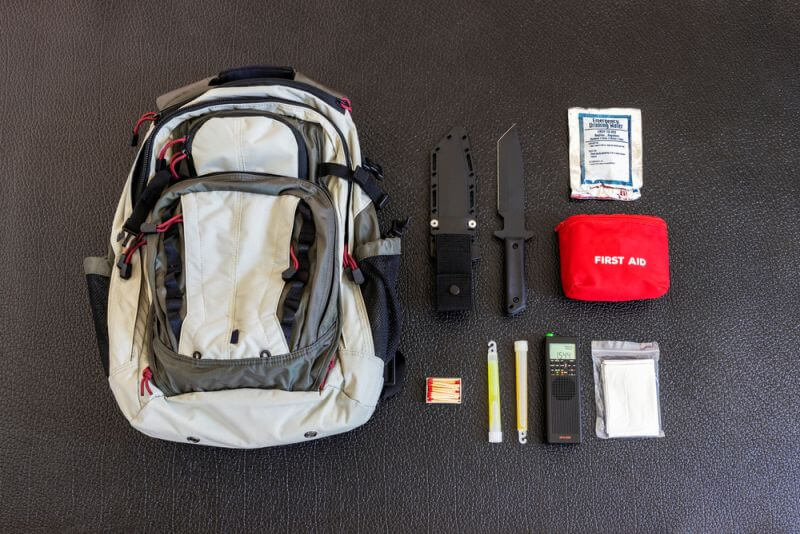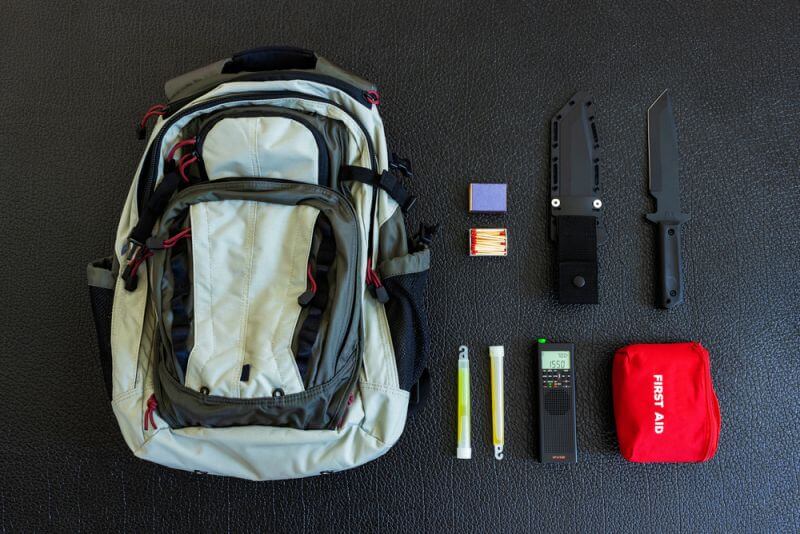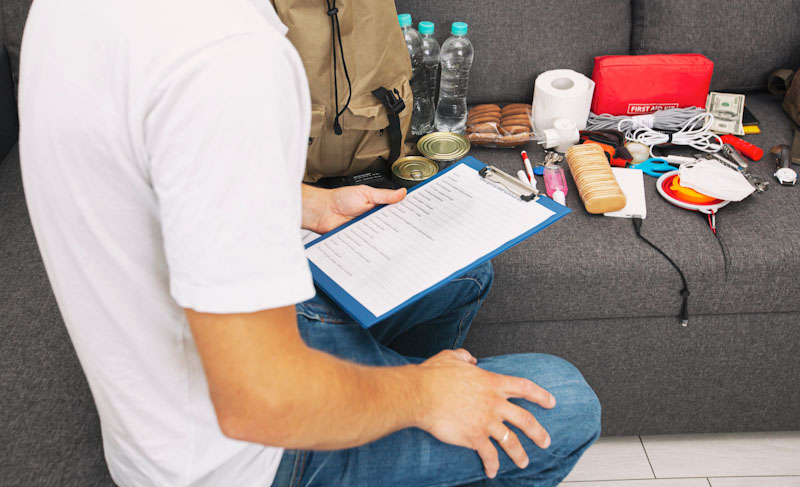Building a bug out bag is a sure sign that someone is a prepper. Typically, one’s first bug out bag is a challenge, just like anything else is the first time. Most of the challenge doesn’t actually come from not having done it before though, it comes from not having the gear on hand. If we have the necessary survival gear on hand, building a bug out bag doesn’t take more than a couple of hours. But finding the gear we want can take days… or considerably longer.
But that’s just putting a basic bug out bag together. The real work starts once that part is done. That’s when we start finding things that we’ve included, which we aren’t satisfied with, just as we find things that we left out, which we really should have included. That few hours or days we spend putting out first bug out bag together grows into years of work, refining and redoing our bug out bag, in a constant effort to make it the best bug out bag we can.
As far as I’m concerned, everything in that bug out bag has to have a reason, or it shouldn’t be there. Just because Uncle Fred carries one, you carried one back in the Army, or your favorite survival guru swears by it, doesn’t mean that it makes sense for you. Ultimately, you’re the one who’s going to have to carry it and you’re the one who’s hopefully going to be using it
I’ve spent years trying to perfect my personal bug out bag and I’m still working on it. Part of that is because I’m constantly finding new gear which would be useful to have. As the prepping movement has grown, more and more inventors have come up with new tools and gear to help us or just muddy the waters. But I’m dealing with something else too; as I age, my survival plans have to change, as I don’t have the strength or endurance I once had. So, I change my bug out bag to match those changes in my survival plan and my personal survival needs.
This process has led me to add things to my bug out bag, which others might not carry, just as it has led me to leave some things out, which are considered common (I talked about that last week). Each of these items has become essential in my mind and has been proven to be effective as I have used it.
You see, I don’t just leave my bug out bag packed and sitting in the closet. I take it out in the woods from time to time, spending a night or two, living with just what I carried in. This is the only way I know to truly test out the effectiveness of my bug out bag and the plans which have gone into creating it. As part of that, I’m looking at just how comfortable I’m going to be, living off of what I’m carrying. Trust me, comfort is important.
Backpacking Tent
I’m not sure why preppers think that they need to build a shelter if they have to bug out. Backpackers solved this problem a couple of generations ago. Modern backpacking tents are ultra-lightweight, compact, easy to set up, and much more weatherproof than anything that we might build out of debris, or even a tarp. The all-season ones even help hold in heat, which is great for the wintertime.
If you think about it, bugging out is a lot like backpacking, especially if we get to the point where we’re forced to abandon our vehicles and go on foot. If we don’t have to abandon our vehicles, that’s even better; but we always need to plan for the worst. What works for backpackers should also work for us.
Backpacking Sleeping Bag
Just as I’ve taken a lesson from backpackers, adding one of their tents to my bug out bag, I’ve added a backpacking sleeping bag. This is especially important during the colder months, as sleeping with nothing more than an emergency blanket isn’t going to be very warm. But some of those backpacking sleeping bags will have you baking in your own sweat, even in the wintertime.
Foam Sleeping Pad
Going hand-in-hand with the backpacking sleeping bag, I carry a foam pad to go under it… at least for my body, if not for my legs. Mine isn’t actually a backpacking pad, as I’ve used a piece of foam rubber I had here, leftover from a project. It’s probably not as durable, even though it has a fabric cover; but it’s soft and lightweight. One of these days I’ll probably replace it with the real thing.
Remember what I said about comfort? If you can’t sleep comfortably, you’re going to have a hard time walking the next day. At my age, I wake up with various aches and pains as it is. I certainly don’t need to be adding to them, by sleeping in such a way that I’ve got a rock sticking into my hip.
Stormproof Lighter
I’ve worked my way through a large collection of fire starters through the years, trying one thing after another. Ultimately, I settled on a Stormproof Lighter. This is a refillable butane lighter, with a piezoelectric igniter. The igniter keeps sparking, as long as the gas valve is depressed, ensuring that if the wind or rain tries to blow it out, it reignites right away. This lighter is so effective, even in the wind, I never have to use anything else. Even so, I also carry stormproof matches, just in case my lighter breaks or I lose it.
Lots of Chemical Fire Starters
Like most preppers, I pride myself in being able to start a fire with one match, or one flick of my stormproof lighter. There is a caveat on that though; that is, I don’t expect to be able to start a fire that easily if it is raining, snowing or windy out. Of course, chances are pretty high that if I have to bug out, it’s going to be raining, snowing and windy, all at the same time. For that reason, I always carry a goodly collection of chemical fire starters.
The big change here isn’t that I’m carrying them, or the type I’m carrying; but how many I’m carrying. I used to carry a half-dozen or so, just to be sure that I was covered for bad weather. But as I’ve come to understand that I would likely be bugging out in wet weather, I’ve upped the quantity. Now I carry at least 50 and I replace them when they start getting old.
Elastic Hair Bands
No, I don’t have a pony tail. But I’ve found elastic hair bands to be excellent for bundling a lot of different things together. They’re also good for temporarily tying sticks together, such as for making a rack to sun dry venison jerky over. There are other things that can be used, but for the cost and weight, I like the hair bands.
Zip Ties
In a way, this is a duplicate for the elastic hair bands, as I use the two in pretty much the same way; but this is one of those places where I let redundancy guide me. Neither these zip ties or the elastic hair bands take up much space or weigh much; so, they’re not a problem to carry. Just make sure you have some small diagonal cutters or nail clippers to cut them open.
Screw-in Tent Stakes
Have you ever been camping and had the wind blow your tent down? That usually starts by the wind loosening the tent stakes. Once they are loose, it doesn’t take much of a puff to blow the tend down. So, the trick is making sure that the tent stakes stay in the ground.
A few years ago, I ran across an ad for screw-in tent stakes. Being the curious sort, I ordered four of the to try them out. I was pleasantly surprised how well they worked. Even in a storm, the stakes held fast, which meant that my tent didn’t blow down. They’re a bit more bulky than carrying normal tent stakes, but since they’re plastic, they’re not heavier.
Work Gloves
A good pair of work gloves can save your hands, working out in the woods. By a good pair, I mean something that fits close to the skin, is durable, and has good gripping surfaces, while protecting your hands. I’ve got a couple of pair that I use for different things, all of which cost me at least $20. But they were worth it. I keep one pair readily accessible, near the top of my bug out bag. That way, I have them available for gathering wood, digging, building rock fireplaces, or scrambling over rockpiles. They’ve saved my fingers many a time, even though I don’t like working in gloves.
Honing Stone
How many people make sure they have a good knife and forget the honing stone. While the possibility exists of finding a stone that you can use to put an edge on your knife, you probably won’t get as good an edge as you will with a true honing stone. That makes it worth carrying.
The stone I carry is actually rather small, measuring no more than three inches in length. It’s a water stone too, rather than an oil stone, saving me the weight and potential mess of carrying the oil. It’s not a perfect solution; but it works.
Extensive Survival Fishing Kit
I came to the conclusion some time back that it’s much easier to harvest food in the wild by fishing, than it is by hunting or gathering. So, even though I’m not a big fan of eating fish (give me a steak any day), I decided that the typical survival fishing kit just wasn’t enough. I mean, just how long do you thing two hooks and one bobber are going to last? So, I’ve greatly expanded my survival fishing kit, which I wrote about a few months ago.
WAPI
The WAPI stands for a water pasteurization indicator. This little device was first created for use in third-world countries, where having water, let alone clean water, could be a very iffy thing. Countless people have become ill or even died from drinking impure water in those countries.
The WAPI consists of a plastic capsule with a wax bead inside. The wax will melt at 160°F, indicating that the water it is in has been pasteurized. In other words, it has been heated enough to kill bacteria and other microscopic pathogens. As 160°F is considerably cooler than the boiling point of water (212°F), being able to purify water by pasteurizing it is much more energy efficient than boiling it. You can even put the WAPI in a bottle of water and place it in the sun, for the sun to heat it and pasteurize it.
Large Solar Charger
Finally, I’ve replaced the small solar chargers that everyone advertises, with a much larger one; specifically, on that has three panels. Those little ones might succeed in charging a phone in three days, assuming you had perfect weather and kept the panel pointed at the sun. Mine still isn’t big enough to ensure a full charge in a day; but it’s a whole lot better than the little ones. Considering how useful a cell phone can be in a survival situation; I consider the ability to charge it to be an important part of my survival.










Becster | November 12, 2024
|
While cutters are good to have, removable/reusable Zip Ties are available now.
Ronald H Levine | November 15, 2024
|
I put up a banner in the winter cold with Zip Ties and it failed overnight due to fatigue from the combination of wind flapping it and the brittleness from the cold. Erroneously blaming it on cheap Chinese manufacturer, I tried two of the expensive American brands and both failed overnight. I went to a Nylon braided cord rated at even less breaking strength and it didn’t fail in the two years we had it up!
I use the same principle of braided cord for my backpacking supplies except I chose Dyneema braid because being fifteen times greater strength than steel, it is much more thin and compact compared to nylon.
[email protected]
Shya | December 5, 2024
|
I agree with most of what you’re saying. Might I ask what you have taken OUT of the B-O-B? Surely you have had to remove something in order to fit this stuff in.
The WAPI is likely to save me a considerable amount of fuel, since the water won’t require as muc to get to a safe point for consumption.
The gloves are a no brainer of course, and I use “ranger bands”, which are nothing more than pieces of inner tubes, sliced in assorted thicknesses.
The stormproof lighters are terrific, but I keep waterproof matches AND a couple of simple Bic lighters, as well. Since fire making is so much at the top of the list, I want backups to my backups on it. As well as several methods for containers for water.
Please, let us know what you no longer keep in your bag? Thanx!
John | December 16, 2024
|
I agree with most of this post with the knowledge that this was written for a beginner prepper. I do have a issue with the solar charger. If you have a lot of devices that need charging (Lights, radios and the like), then yes. It might save some weight as opposed to caring a bunch of extra batteries if the solar charger also has a storage battery inside (power bank). Also, how many preppers practice starting fires in a rain storm? Every time we have a monsoon rain storm, I’m out there in the rain, making fire with what is laying out in the open. This last summer, our MAG had a meeting when a monsoon moved in. Everyone wanted to end the meeting, but I had everyone try to make a fire. Of the 8 people in our mag, only 3 of us were able to get a good size fire started. Now everyone practices starting fires in the rain. People have to practice their bug out skills or you don’t have skills. Keep your bug-out-bag to a max of 15 to 20% of your body weight or if you have a long walk, you are going to be very tired. My BOB weighs 35 pounds and my wife’s weigh 22 pounds. I am 175 pounds and she is 124 pounds. We have covered as much as 23 miles a day carrying our BOB’s for 4 days. We averaged about 16 miles a day. We were also carrying our firearms (handguns and long guns). I am 70 and she is 68. We both workout 3 times a week and also take martial arts once a week. Yes, we are both retired, so we have the time. You must stay in shape as you never know when you might have to walk for whatever reason.